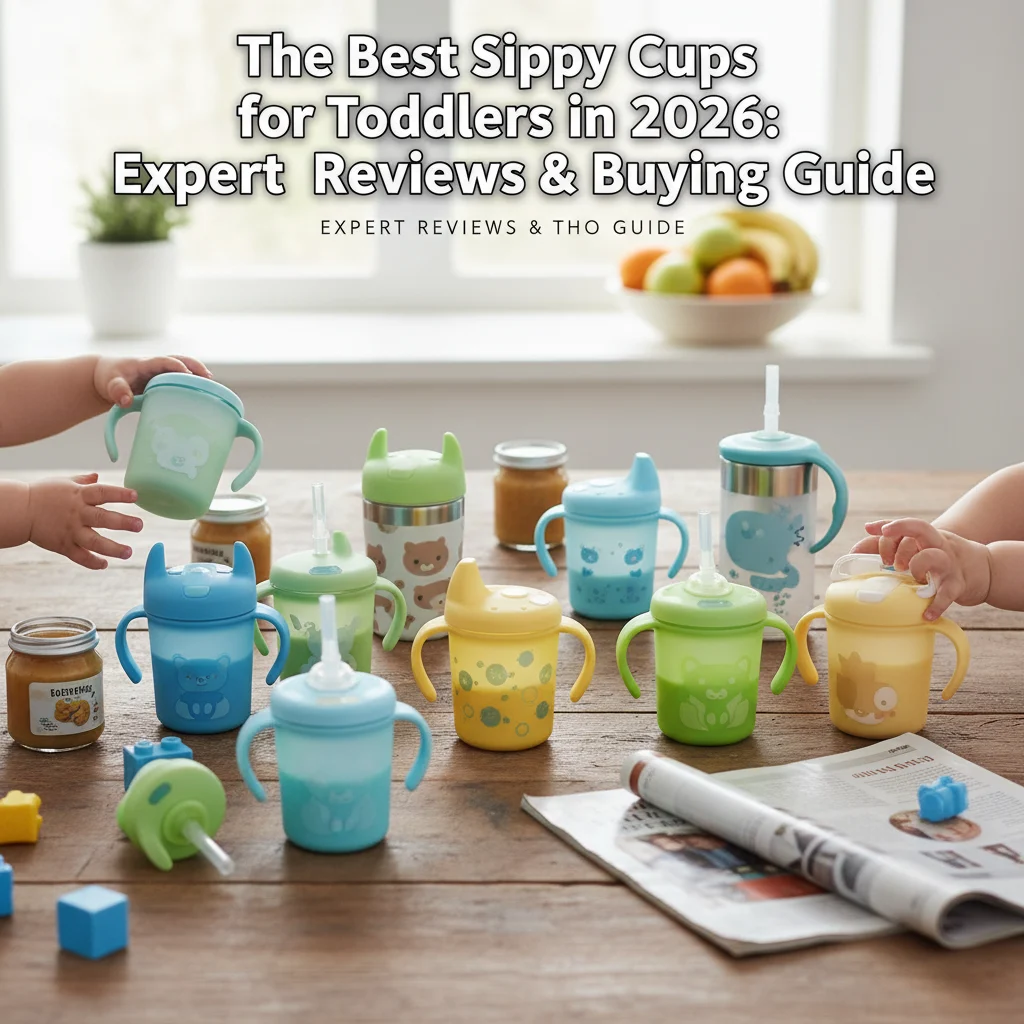[Get the best value toddler sippy cups on Amazon today!]
# The Best Sippy Cups for Toddlers in 2026: Expert Reviews & Buying Guide
Choosing the right sippy cup for your toddler can feel like navigating a minefield. Leaks, spills, and picky little ones can make the process frustrating. But fear not! In this guide, we’ll dive into the best sippy cups for toddlers in 2026, based on expert reviews and real-world testing. We’ll help you find the perfect cup to keep your little one hydrated and happy (and your floors clean!). We’ve done the research, so you don’t have to. Get ready for a leak-proof, toddler-approved adventure!
**Top Picks Summary**
| Sippy Cup | Best For |
| :————————————— | :——————————— |
| Munchkin Miracle 360 Trainer Cup | Overall Leak-Proof Performance |
| Philips Avent My Little Sippy Cup | Transitioning from Bottle to Cup |
| OXO Tot Transitions Straw Cup with Handles | Straw Sipping |
### Munchkin Miracle 360 Trainer Cup
**Best For:** Overall Leak-Proof Performance
**Key Features:**
* 360-degree drinking edge allows drinking from any side of the cup.
* Automatically seals when child stops drinking to completely eliminate spills.
* Easy to clean with no extra valves or parts.
* BPA-free and top-rack dishwasher safe.
**Why We Like It:** The Munchkin Miracle 360 Trainer Cup truly lives up to its name. It’s incredibly leak-proof, even when tossed around by enthusiastic toddlers. The 360-degree drinking edge makes it easy for kids to learn to drink from a cup without the mess. Parents will appreciate the simple design and easy cleaning. This is a solid all-around choice for toddlers of all ages.
### Philips Avent My Little Sippy Cup
**Best For:** Transitioning from Bottle to Cup
**Key Features:**
* Angled spout designed to help toddlers take their first sips easily.
* Soft silicone spout is gentle on gums.
* Few parts for easy assembly and cleaning.
* Compatible with Philips Avent bottles and nipples.
**Why We Like It:** If you’re looking to transition your baby from a bottle to a sippy cup, the Philips Avent My Little Sippy Cup is an excellent choice. The angled spout makes it easier for little ones to drink without tilting their heads back too far, and the soft silicone is gentle on their gums. The compatibility with other Avent products is a bonus for parents who already use the brand. It’s a great starter sippy cup. Plus, the handles are perfectly sized for little hands.
### OXO Tot Transitions Straw Cup with Handles
**Best For:** Straw Sipping
**Key Features:**
* Angled straw encourages natural drinking position.
* Weighted straw allows toddlers to drink from any angle.
* Leak-proof lid prevents spills when not in use.
* Removable handles for easy gripping.
**Why We Like It:** For toddlers who prefer drinking from a straw, the OXO Tot Transitions Straw Cup with Handles is a winner. The angled and weighted straw allows them to drink from any angle, whether they’re sitting, standing, or lying down. The leak-proof lid keeps messes to a minimum, and the removable handles make it easy for them to hold. It’s a fantastic straw sippy cup that grows with your child.
[Browse top-rated toddler sippy cups on Amazon]
## Buying Guide: What to Consider When Choosing Toddler Sippy Cups
Choosing the right sippy cup for your toddler involves more than just picking a cute design. Several factors can impact your child’s drinking experience, your sanity, and your wallet. Here’s a breakdown of the most important things to consider:
**1. Material:**
* **Plastic:** The most common material, plastic sippy cups are lightweight, durable, and often the most affordable. Look for BPA-free and phthalate-free options to ensure your child’s safety. Some plastics can also retain odors or stains over time.
* **Silicone:** Silicone sippy cups are soft, flexible, and heat-resistant. They’re a good choice for babies and toddlers with sensitive gums. Silicone is also naturally BPA-free and easy to clean. However, silicone cups can sometimes be more expensive than plastic ones.
* **Stainless Steel:** Stainless steel sippy cups are durable, non-toxic, and resistant to bacteria and odors. They can also help keep drinks cold for longer. However, they’re typically heavier and more expensive than plastic or silicone cups.
**2. Spout Type:**
* **Soft Spout:** Soft spouts are gentle on gums and resemble a bottle nipple, making them a good choice for transitioning babies. However, they can be more prone to leaks and may encourage a sucking motion rather than sipping.
* **Hard Spout:** Hard spouts are more durable and encourage a more mature drinking style. They are less prone to leaks than soft spouts, but can be harder for babies to get used to initially.
* **Straw:** Straw sippy cups allow toddlers to drink without tilting the cup as much, reducing the risk of spills. They also promote a more natural drinking motion. Look for weighted straws that allow drinking from any angle.
* **360-Degree:** These cups have a valve that allows drinking from any side of the rim. They’re designed to mimic drinking from a regular cup and help toddlers develop their sipping skills. They are generally very leak-proof.
**3. Leak-Proof Design:**
Let’s face it: leaks are the enemy. Look for sippy cups with features like valves, seals, and tight-fitting lids to minimize spills. Read reviews to see what other parents say about a cup’s leak-proof performance. Keep in mind that even the most leak-proof cups may leak if they’re not assembled correctly or if the valve is damaged.
**4. Ease of Cleaning:**
Sippy cups can be breeding grounds for bacteria if they’re not cleaned properly. Choose cups with few parts that are easy to disassemble and clean. Dishwasher-safe cups are a major convenience. Pay attention to small parts like valves and seals, which can be tricky to clean.
**5. Size and Weight:**
Consider your toddler’s age and size when choosing a sippy cup. Smaller cups are easier for younger toddlers to hold. Lightweight cups are less likely to be dropped. As your child grows, you can move to larger cups.
**6. Handles:**
Handles can make it easier for toddlers to grip and control the cup, especially when they’re first learning to drink independently. Look for handles that are ergonomically designed and easy to grip. Some cups have removable handles, allowing you to transition to a handle-free cup as your child gets older.
**7. Durability:**
Toddlers can be tough on their belongings. Choose sippy cups made from durable materials that can withstand drops, throws, and general wear and tear. Read reviews to see how well a cup holds up over time.
**8. Age Appropriateness:**
Sippy cups are often labeled with age recommendations. Pay attention to these recommendations when choosing a cup for your child. Younger babies may need a soft spout, while older toddlers may be ready for a straw or 360-degree cup.
**9. Valve Design**
The valve is the key to leak-prevention, but also can make it hard for a child to actually get a drink. Some valves require a certain amount of suction. If your child isn’t getting anything out of the cup, the valve may be too tight. Test it yourself before giving it to your child.
**10. Price**
Sippy cups range in price from a few dollars to over $20. Consider your budget and how many cups you need. It’s often worth investing in a few high-quality cups that will last longer and perform better than cheaper options.
**11. Design**
While functionality is key, don’t underestimate the power of a fun design! Toddlers are more likely to use a sippy cup they like the look of. Look for cups with bright colors, fun characters, or interesting shapes.
**12. Brand Reputation and Warranty:**
Consider purchasing from reputable brands known for producing quality baby products. Check if the sippy cup comes with a warranty. A warranty can provide peace of mind in case of defects or premature wear and tear.
**Specific Sippy Cup Types in Detail:**
Let’s delve deeper into the different types of sippy cups and their suitability for various stages of toddler development.
* **Transition Cups:** These are designed specifically for babies transitioning from bottles or breastfeeding. They often feature soft spouts or nipples that mimic the feel of a bottle, making the transition easier. They usually have handles for easy gripping.
* **Spoutless Cups (360 Cups):** These cups have a valve that allows drinking from any edge of the rim, similar to drinking from a regular cup. They help toddlers develop sipping skills and can reduce the risk of tooth decay compared to prolonged sucking from a spout.
* **Straw Cups:** Straw cups are a good choice for toddlers who have mastered the sucking reflex. They encourage a more natural drinking motion and can help prevent spills. Look for weighted straws that allow drinking from any angle.
* **Insulated Cups:** Insulated sippy cups keep drinks cold (or warm) for longer, making them ideal for outings or travel. They’re often made from stainless steel or double-walled plastic.
* **Valve-Free Cups:** Some si
[Check the latest prices and deals for toddler sippy cups on Amazon today!]









